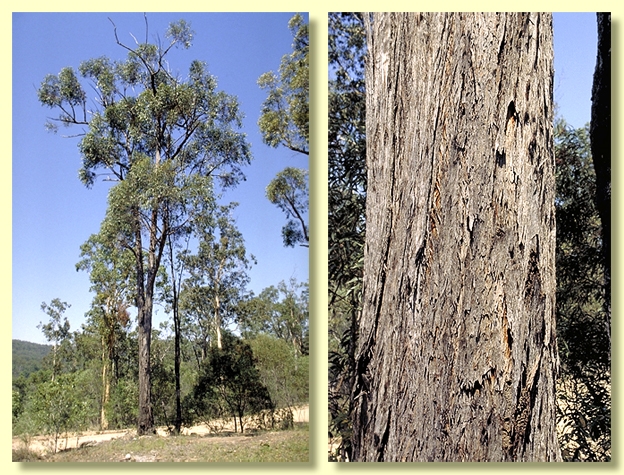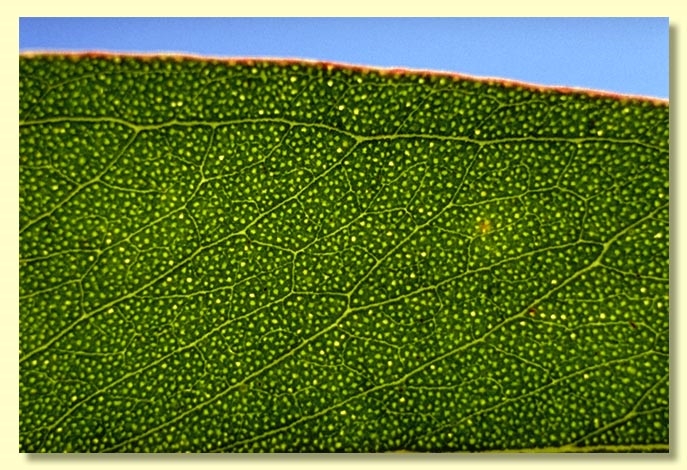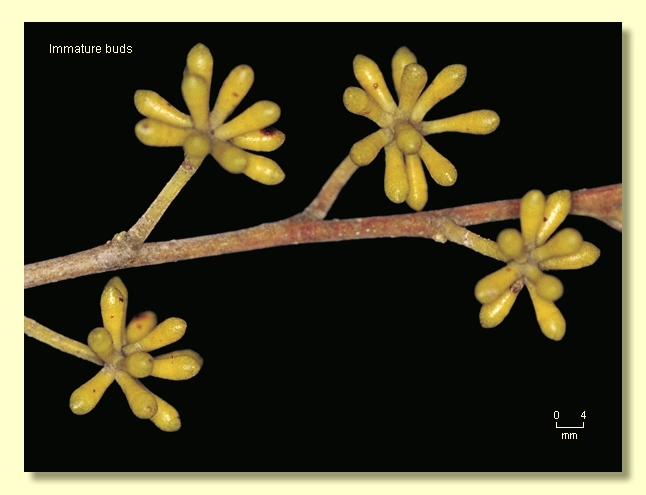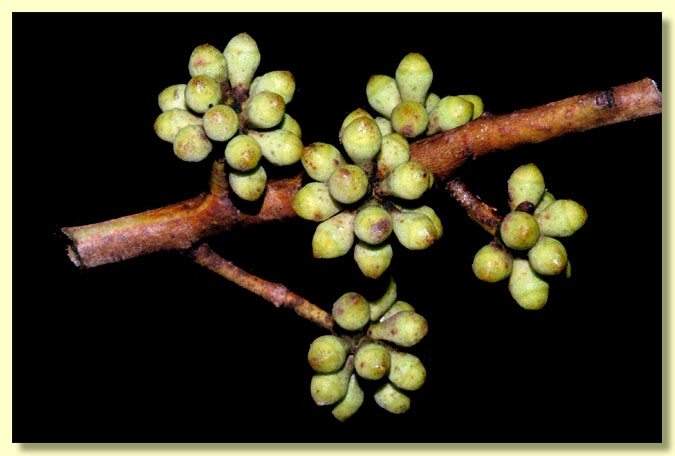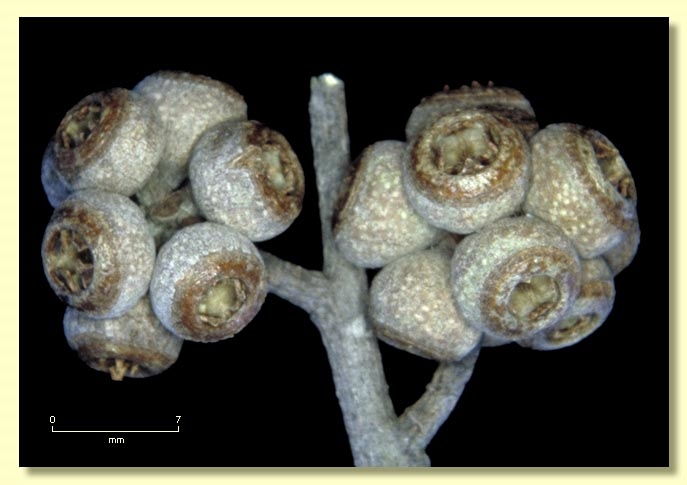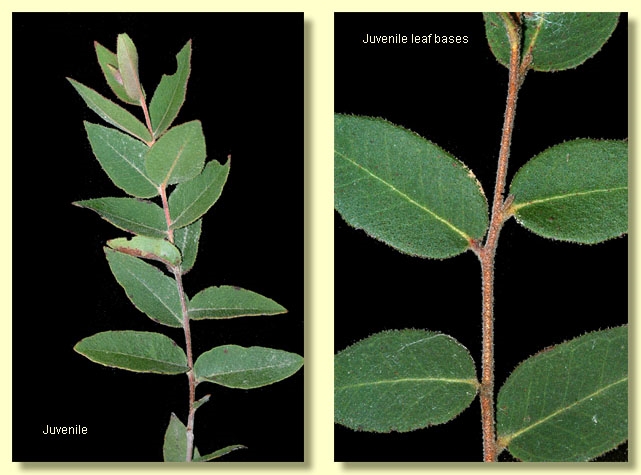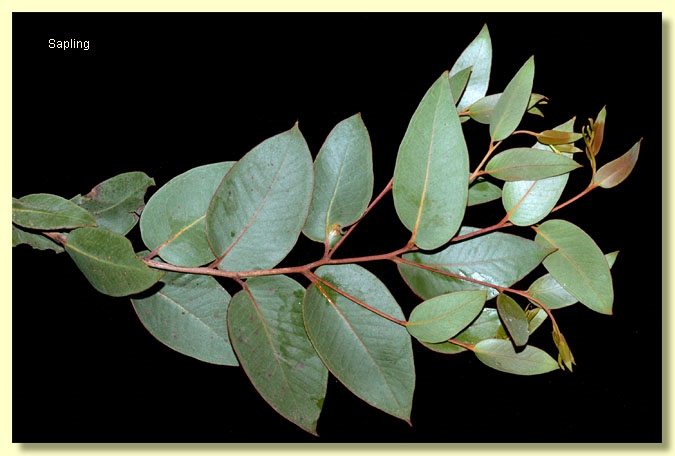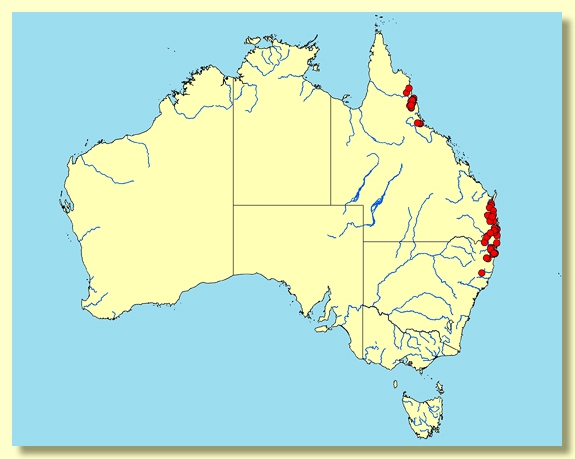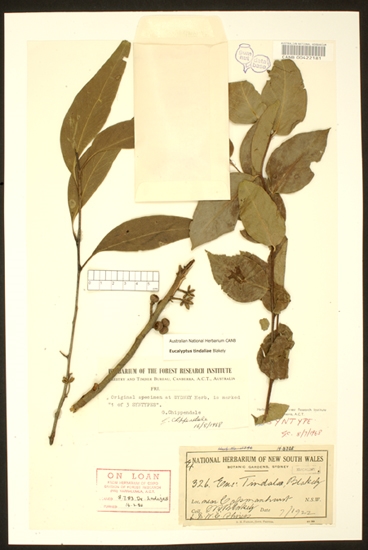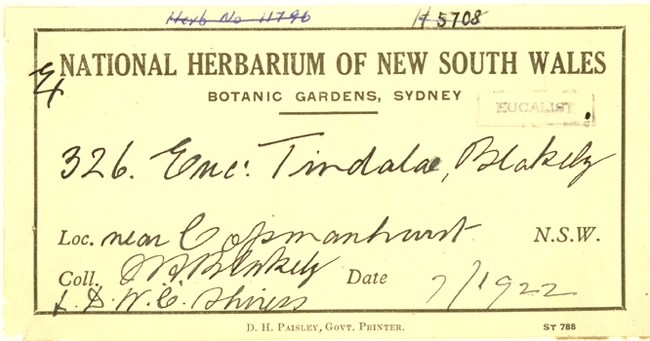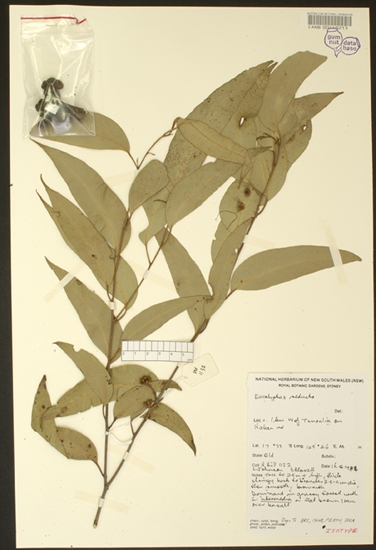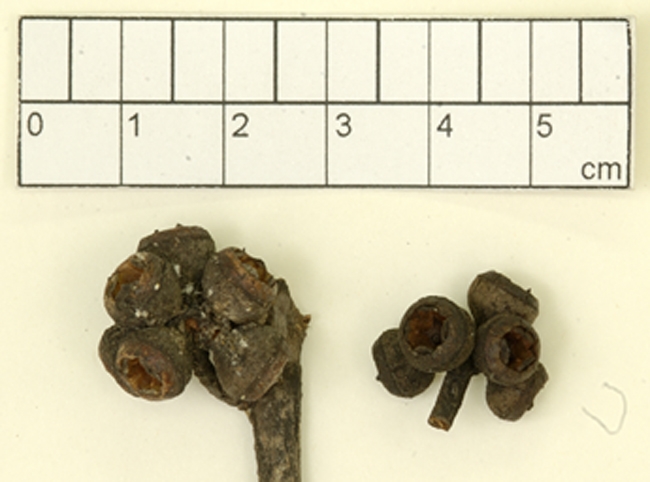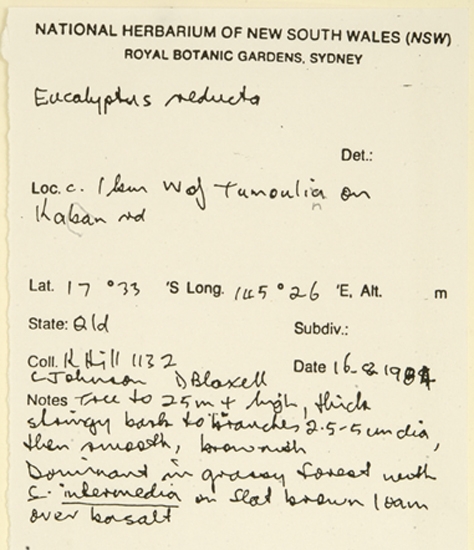Euclid - Online edition
Eucalyptus tindaliae
Eucalyptus | Eucalyptus | Capillulus | Pachyphloius
T: near Copmanhurst, NSW, 28 July 1922, W.F.Blakely & D.W.C.Shiress s.n.; syn: CANB, K, NSW; Orara Ck, 16 km S of Ramornie, NSW, 28 July 1922, W.F.Blakely & D.W.C.Shiress s.n.; syn: NSW; ?Denman, NSW, Jan. 1909, W.Heron s.n.; herbarium of cited specimen not known to us.
Eucalyptus reducta L.A.S.Johnson & K.D.Hill, Telopea 4: 344 (1991). T: Queensland: 1 km W of Tumoulin on Kaban road (17°33'S 145°26'E), 16 Aug. 1984, K.D.Hill 1132, L.A.S.Johnson & D.F.Blaxell; holo: NSW; iso: BRI, CANB, MEL.
Tall tree to 30 m, rarely a mallee on extreme sites. Forming a lignotuber.
Bark rough on trunk and branches to about 6 cm diameter, stringy with shallow longitudinal fissures, grey and grey-brown.
Juvenile growth (coppice or field seedlings to 50 cm): stem rounded in cross-section, usually hairy or scabrid; juvenile leaves sessile to shortly petiolate, usually opposite for up to 50 cm tall but may become alternate earlier, ovate to lanceolate, rarely ± orbicular, 3–9.5 cm long, 1.4–4.5 cm wide, base tapering to petiole, margin undulate and irregular on earlier leaves, discolorous, glossy, green; new growing tips, stems and leaves usually hairy or scabrid for many pairs (at least 16).
Adult leaves alternate, petiole 0.6–2 cm long; blade lanceolate to falcate, rarely ovate, 6–14 cm long, 1.2–3.7 cm wide, base oblique or tapering to petiole, usually concolorous, rarely slightly discolorous, glossy or dull, green to blue-green, side veins acute, sparsely reticulate or reticulation absent, intramarginal vein parallel to and just within margin or well removed from it, oil glands island.
Inflorescence axillary unbranched, peduncles 0.5–1.8 cm long, buds in umbels of 9 to 15, sessile or on pedicels to 0.2 cm long. Mature buds buds obovoid to ovoid, 0.3–0.7 cm long, 0.3–0.4 cm wide, yellow, scar absent, operculum conical to rounded, stamens irregularly flexed, anthers reniform to cordate, versatile, dorsifixed, dehiscing by confluent slits, style long, stigma blunt or tapered, locules usually 4 rarely 5, the placentae each with 2 vertical ovule rows. Flowers white.
Fruit sessile or on pedicels to 0.2 cm long, hemispherical or truncate-globose, 0.3–0.7 cm long, 0.6–1 cm wide, disc raised-convex to oblique, or level, rarely descending, valves 3 or 4, rarely 5, slightly exserted, near rim level or enclosed.
Seeds brown to blackish, 1–3 mm long, pyramidal or obliquely pyramidal, dorsal surface smooth, hilum terminal.
Cultivated seedlings (measured at ca node 10): cotyledons reniform; stems rounded in cross-section, stellate-hairy; leaves at least shortly petiolate, opposite for 5 to 10 nodes then alternate, ovate to lanceolate, 4.4–9.5 cm long, 2–4.2 cm wide, base rounded to tapering, rarely amplexicaul, margin irregular, apex pointed, discolorous, mid-green above, paler beneath, sparsely stellate-hairy on both surfaces.
Flowering has been recorded in May, June and August in tropical north-eastern Australia and in more southerly warm-temperate areas in January, February and March.
A small to tall stringybark tree widespread in coastal and subcoastal areas from Grafton and Lismore area of far north-eastern New South Wales north to Mt Spec, Atherton Tableland, Windsor Tableland and Helenvale areas in northern Queensland. The distribution is not continuous and the species is largely absent from Maryborough to Townsville. It occurs on gentle slopes in coastal lowlands, and foothills, and in the north, on tablelands, and prefers sandy soils.
Eucalyptus tindaliae has long-fibred rough (stringy) bark extending to the branchlets, concolorous leaves, a slightly bluish green crown, ovoid buds and rather crowded large fruit in southern localities, but slightly smaller fruit in northern localities of Queensland. Juvenile growth is scabrid for many leaf pairs.
Eucalyptus tindaliae will be difficult to distinguish from any other stringybark species in south-eastern Queensland and adjacent north-eastern New South Wales. The other stringy bark species in the area are E. laevopinea, which has only slightly scabrid juveniles and more conspicuously pedicellate buds with consistently conical operculum; E. youmanii, which differs having slightly angled fusiform to diamond-shaped buds; E. caliginosa, with only slightly scabrid juveniles, obviously pedicellate ovoid buds with conical operculum and fruit with well-exserted valves; E. conglomerata, which has scabrid/hairy juveniles, smaller buds, smaller fruit tightly clustered together, and prefers low-lying seasonally swampy wallum (heath); E. eugenioides, which has juveniles scabrid/hairy for many nodes, thin-textured adult leaves and buds with a conical to slightly beaked operculum; E. cameronii, which has small ovate-elliptic slightly scabrid juvenile growth for many nodes, ovoid pedicellate buds and smallish fruit. In the north of the range of E. tindaliae (north from Townsville) there are no other stringybark species.
In the Glasshouse Mountains area of south-eastern Queensland E. tindaliae is a common tree in forested areas and also occurs as a stunted shrub or mallee on high exposed sites, e.g. the upper and middle slopes of Mount Tibrogargan.
In 1991 Hill & Johnson described Eucalyptus reducta from far north Queensland, stating that it differed from E. tindaliae in having smaller adult leaves and smaller fruit with only three locules. Our measurements show that the two species overlap almost completely in adult leaf dimensions, and in fruit length and widths. Fruit of E. tindaliae does tend to have four locules but fruit with three locules do occur. Because the differences between these two taxa are slight we synonymise E. reducta with E. tindaliae.
Over the range of Eucalyptus tindaliae other species with long-fibred stringy-type bark which could be superficially confused are: the so-called red mahogany species, E. pellita, E. resinifera and E. notabilis, which have distinctly discolorous leaves, buds initially with two opercula but which shed the outer operculum early in bud development leaving a scar, fruit with prominently exserted valves, and seedlings and juvenile growth always completely glabrous; and the white mahogany species, E. apothalassica, E. carnea, E. latisinensis and E. acmenoides, all of which have crown leaves with very densely reticulate venation (sparse in E. tindaliae), axillary buds in umbels clustered towards the ends of the branches and juvenile growth completely glabrous.
MORE ABOUT STRINGYBARKS

